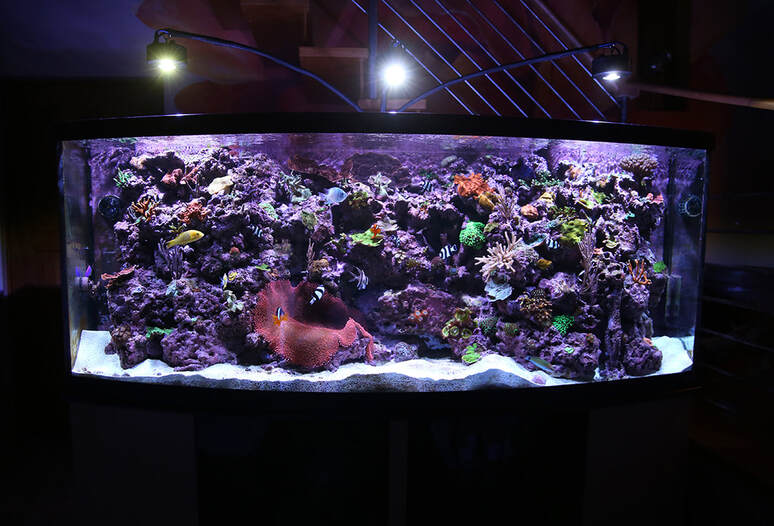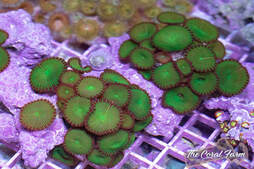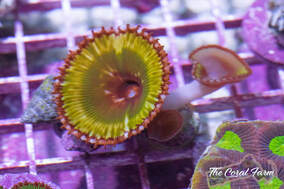|
Short story written in part by ChatGPT A.I. and photo above created in part by Wonder A.I. It was Christmas morning, and the man woke up with a feeling of excitement and anticipation. He had been hoping for a very special gift, and he couldn't wait to see what was waiting for him under the tree. He rushed downstairs and tore open the wrapping paper, revealing a crisp white box with a big blue sticker on it that read "TheCoralFarm.com". He popped open the Styrofoam container to reveal a beautiful, pink and purple Lobo coral. It was his favorite type of coral, and he had been longing for one for years. The man was overjoyed, and he quickly set about preparing a spot for the coral in his aquarium. He carefully placed it among the rocks and other corals, and watched as it began to puff up in agreement. Over the next few days, the man watched with amazement as the coral grew and flourished. It was a sight to behold, and it brought him great joy and satisfaction. As the weeks and months passed, the man cared for his coral with love and dedication. He regularly cleaned the aquarium, provided the right nutrients and lighting, and made sure that the water was always just right. And as the coral continued to grow and thrive, the man realized that his Christmas gift was not just a beautiful piece of coral, but a source of endless wonder and delight. It was the perfect gift, and he was grateful for it every day. We love this story!Let's make it happen! We have some ideas that will help you successfully give the GIFT OF CORALS under the Christmas this year. 1) If you are local to a reef shop arrange to pick them up the day before Christmas. Keep them as close to 76F degrees as you can even if it means turning up the heat in the house a little bit. Most corals will be fine even down to the mid 60's but not over the low 80's. So keep them warm but don't put them next to the heater. Most corals will be fine in the bag for 2 days if you keep them warm. 2) Gift Cards are great! You are off the hook for picking out the corals and they get to pick that perfect coral of their dreams. 3) Buy now and ship later. You can print out photos of the corals you bought and wrap them up as stocking stuffers! Get that look of joy over and over again for each coral photo they discover. We can arrange shipping after all the holiday craziness. Read More: The "Do's and Don'ts of Gifting Corals"
0 Comments
 Saltwater reef aquariums are a popular and rewarding hobby that allows hobbyists to create their own little slice of the ocean in their own home. These aquariums are home to a diverse array of colorful and fascinating marine life, including fish, corals, and invertebrates. Starting a saltwater reef aquarium can be a daunting task, but with the right knowledge and planning, it can be a rewarding and fulfilling experience. Here are some key things to consider when setting up a saltwater reef aquarium:
Overall, starting a saltwater reef aquarium can be a challenging but rewarding hobby. With the right setup and care, you can create a thriving and beautiful aquatic environment that will provide enjoyment for years to come. For more information about equipment and additives visit: Reefkeeping Tips
Safety precautions are recommended. It is important to handle zoanthus corals with care and avoid inhaling or ingesting any water that may contain palytoxin. It is also important to thoroughly wash your hands and working areas after handling these corals. Wearing gloves and eye protection is advised. Do not cut these corals on a wet saw as this can cause airborne droplets to form which may be inhaled or land on surfaces causing contamination. Real Stories from Fellow Reefers...
Palytoxin is one of the most poisonous non-protein substances known to man. It should be taken seriously and if you are going to own these animals it's important to be informed on the dangers that go along with caring for them. They are beautiful animals that can be enjoyed safely, so long as you take proper safety measures.
|
Categories
All
AuthorBrian Hale has enjoyed 25+ years of dedicated involvement in the reefing community. His commitment to research and extensive hands-on experience makes him an invaluable source of expertise within the reefing hobby. |
Buy Corals Online: TheCoralFarm.com
Aquacultured Corals - Fast Nationwide Shipping USA
1-800-254-4253
Aquacultured Corals - Fast Nationwide Shipping USA
1-800-254-4253




 RSS Feed
RSS Feed
